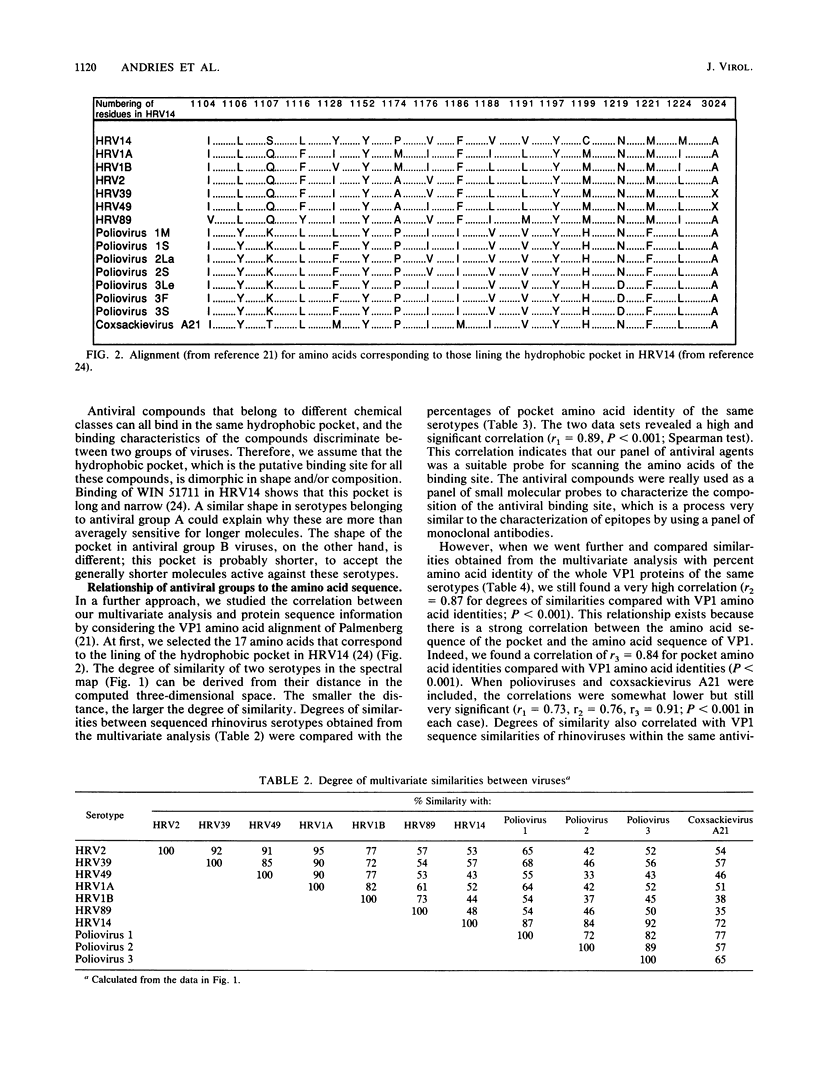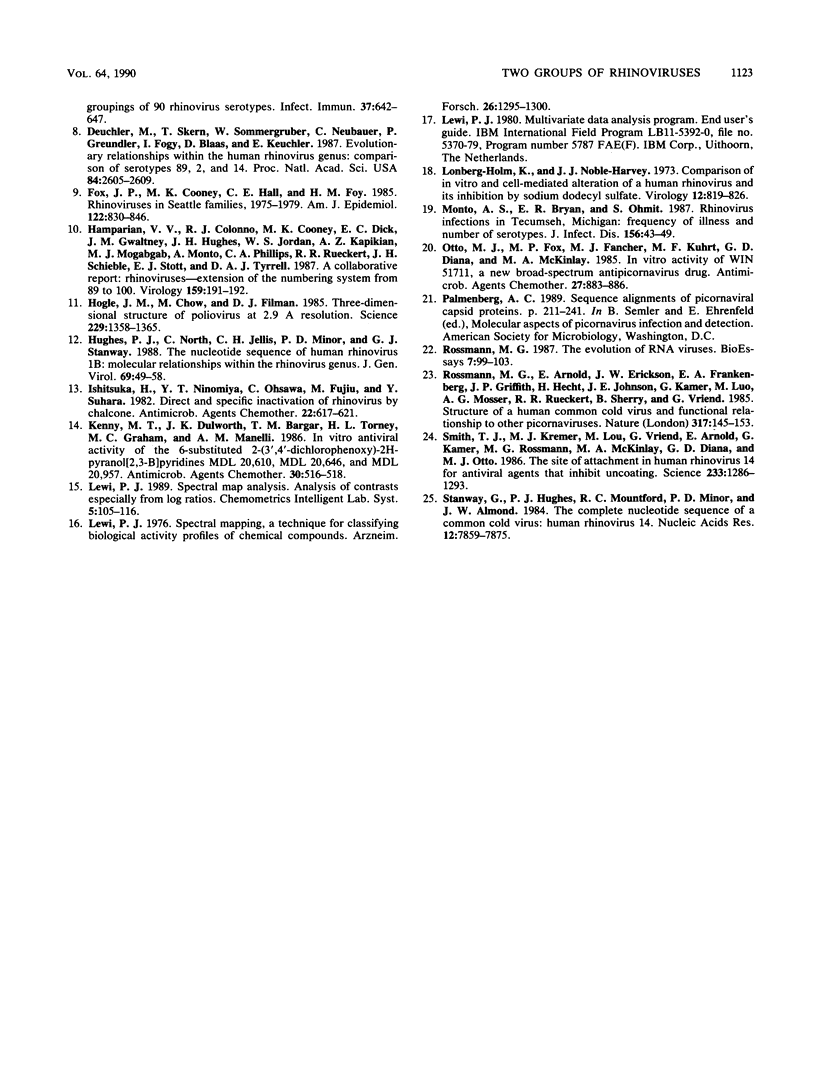Abstract
A variety of chemically different compounds inhibit the replication of several serotypes of rhinoviruses (common-cold viruses). We noticed that one of these antiviral compounds, WIN 51711, had an antiviral spectrum clearly distinctive from a consensus spectrum or other capsid-binding compounds, although all of them were shown to share the same binding site. A systematic evaluation of all known rhinovirus capsid-binding compounds against all serotyped rhinoviruses was therefore initiated. Multivariate analysis of the results revealed the existence of two groups of rhinoviruses, which we will call antiviral groups A and B. The differential sensitivity of members of these groups to antiviral compounds suggests the existence of a dimorphic binding site. The antiviral groups turned out to be a reflection of a divergence of rhinovirus serotypes on a much broader level. Similarities in antiviral spectra were highly correlated with sequence similarities, not only of amino acids lining the antiviral compound-binding-site, but also of amino acids of the whole VP1 protein. Furthermore, analysis of epidemiological data indicated that group B rhinoviruses produced more than twice as many clinical infections per serotype than group A rhinoviruses did. Rhinoviruses belonging to the minor receptor group were without exception all computed to lie in the same region of antiviral group B.
Full text
PDF






Selected References
These references are in PubMed. This may not be the complete list of references from this article.
- Abraham G., Colonno R. J. Many rhinovirus serotypes share the same cellular receptor. J Virol. 1984 Aug;51(2):340–345. doi: 10.1128/jvi.51.2.340-345.1984. [DOI] [PMC free article] [PubMed] [Google Scholar]
- Andries K., Dewindt B., De Brabander M., Stokbroekx R., Janssen P. A. In vitro activity of R 61837, a new antirhinovirus compound. Arch Virol. 1988;101(3-4):155–167. doi: 10.1007/BF01310997. [DOI] [PMC free article] [PubMed] [Google Scholar]
- Andries K., Dewindt B., Snoeks J., Willebrords R. Lack of quantitative correlation between inhibition of replication of rhinoviruses by an antiviral drug and their stabilization. Arch Virol. 1989;106(1-2):51–61. doi: 10.1007/BF01311037. [DOI] [PubMed] [Google Scholar]
- Ash R. J., Parker R. A., Hagan A. C., Mayer G. D. RMI 15,731 (1-[5-tetradecyloxy-2-furanyl]-ethanone), a new antirhinovirus compound. Antimicrob Agents Chemother. 1979 Sep;16(3):301–305. doi: 10.1128/aac.16.3.301. [DOI] [PMC free article] [PubMed] [Google Scholar]
- Bauer D. J., Selway J. W., Batchelor J. F., Tisdale M., Caldwell I. C., Young D. A. 4',6-Dichloroflavan (BW683C), a new anti-rhinovirus compound. Nature. 1981 Jul 23;292(5821):369–370. doi: 10.1038/292369a0. [DOI] [PMC free article] [PubMed] [Google Scholar]
- Colonno R. J., Condra J. H., Mizutani S., Callahan P. L., Davies M. E., Murcko M. A. Evidence for the direct involvement of the rhinovirus canyon in receptor binding. Proc Natl Acad Sci U S A. 1988 Aug;85(15):5449–5453. doi: 10.1073/pnas.85.15.5449. [DOI] [PMC free article] [PubMed] [Google Scholar]
- Cooney M. K., Fox J. P., Kenny G. E. Antigenic groupings of 90 rhinovirus serotypes. Infect Immun. 1982 Aug;37(2):642–647. doi: 10.1128/iai.37.2.642-647.1982. [DOI] [PMC free article] [PubMed] [Google Scholar]
- Duechler M., Skern T., Sommergruber W., Neubauer C., Gruendler P., Fogy I., Blaas D., Kuechler E. Evolutionary relationships within the human rhinovirus genus: comparison of serotypes 89, 2, and 14. Proc Natl Acad Sci U S A. 1987 May;84(9):2605–2609. doi: 10.1073/pnas.84.9.2605. [DOI] [PMC free article] [PubMed] [Google Scholar]
- Fox J. P., Cooney M. K., Hall C. E., Foy H. M. Rhinoviruses in Seattle families, 1975-1979. Am J Epidemiol. 1985 Nov;122(5):830–846. doi: 10.1093/oxfordjournals.aje.a114166. [DOI] [PubMed] [Google Scholar]
- Hamparian V. V., Colonno R. J., Cooney M. K., Dick E. C., Gwaltney J. M., Jr, Hughes J. H., Jordan W. S., Jr, Kapikian A. Z., Mogabgab W. J., Monto A. A collaborative report: rhinoviruses--extension of the numbering system from 89 to 100. Virology. 1987 Jul;159(1):191–192. doi: 10.1016/0042-6822(87)90367-9. [DOI] [PubMed] [Google Scholar]
- Hogle J. M., Chow M., Filman D. J. Three-dimensional structure of poliovirus at 2.9 A resolution. Science. 1985 Sep 27;229(4720):1358–1365. doi: 10.1126/science.2994218. [DOI] [PubMed] [Google Scholar]
- Hughes P. J., North C., Jellis C. H., Minor P. D., Stanway G. The nucleotide sequence of human rhinovirus 1B: molecular relationships within the rhinovirus genus. J Gen Virol. 1988 Jan;69(Pt 1):49–58. doi: 10.1099/0022-1317-69-1-49. [DOI] [PubMed] [Google Scholar]
- Ishitsuka H., Ninomiya Y. T., Ohsawa C., Fujiu M., Suhara Y. Direct and specific inactivation of rhinovirus by chalcone Ro 09-0410. Antimicrob Agents Chemother. 1982 Oct;22(4):617–621. doi: 10.1128/aac.22.4.617. [DOI] [PMC free article] [PubMed] [Google Scholar]
- Kenny M. T., Dulworth J. K., Bargar T. M., Torney H. L., Graham M. C., Manelli A. M. In vitro antiviral activity of the 6-substituted 2-(3',4'-dichlorophenoxy)-2H-pyrano[2,3-b]pyridines MDL 20,610, MDL 20,646, and MDL 20,957. Antimicrob Agents Chemother. 1986 Sep;30(3):516–518. doi: 10.1128/aac.30.3.516. [DOI] [PMC free article] [PubMed] [Google Scholar]
- Lewi P. J. Spectral mapping, a technique for classifying biological activity profiles of chemical compounds. Arzneimittelforschung. 1976;26(7):1295–1300. [PubMed] [Google Scholar]
- Lonberg-Holm K., Noble-Harvey J. Comparison of in vitro and cell-mediated alteration of a human Rhinovirus and its inhibition by sodium dodecyl sulfate. J Virol. 1973 Oct;12(4):819–826. doi: 10.1128/jvi.12.4.819-826.1973. [DOI] [PMC free article] [PubMed] [Google Scholar]
- Monto A. S., Bryan E. R., Ohmit S. Rhinovirus infections in Tecumseh, Michigan: frequency of illness and number of serotypes. J Infect Dis. 1987 Jul;156(1):43–49. doi: 10.1093/infdis/156.1.43. [DOI] [PubMed] [Google Scholar]
- Otto M. J., Fox M. P., Fancher M. J., Kuhrt M. F., Diana G. D., McKinlay M. A. In vitro activity of WIN 51711, a new broad-spectrum antipicornavirus drug. Antimicrob Agents Chemother. 1985 Jun;27(6):883–886. doi: 10.1128/aac.27.6.883. [DOI] [PMC free article] [PubMed] [Google Scholar]
- Rossmann M. G., Arnold E., Erickson J. W., Frankenberger E. A., Griffith J. P., Hecht H. J., Johnson J. E., Kamer G., Luo M., Mosser A. G. Structure of a human common cold virus and functional relationship to other picornaviruses. Nature. 1985 Sep 12;317(6033):145–153. doi: 10.1038/317145a0. [DOI] [PubMed] [Google Scholar]
- Rossmann M. G. The evolution of RNA viruses. Bioessays. 1987 Sep;7(3):99–103. doi: 10.1002/bies.950070302. [DOI] [PubMed] [Google Scholar]
- Smith T. J., Kremer M. J., Luo M., Vriend G., Arnold E., Kamer G., Rossmann M. G., McKinlay M. A., Diana G. D., Otto M. J. The site of attachment in human rhinovirus 14 for antiviral agents that inhibit uncoating. Science. 1986 Sep 19;233(4770):1286–1293. doi: 10.1126/science.3018924. [DOI] [PubMed] [Google Scholar]
- Stanway G., Hughes P. J., Mountford R. C., Minor P. D., Almond J. W. The complete nucleotide sequence of a common cold virus: human rhinovirus 14. Nucleic Acids Res. 1984 Oct 25;12(20):7859–7875. doi: 10.1093/nar/12.20.7859. [DOI] [PMC free article] [PubMed] [Google Scholar]


